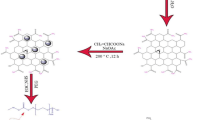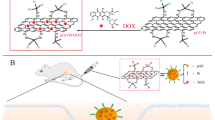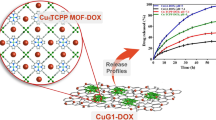Abstract
A de novo drug delivery nanosystem based on gold nanoparticles (GNPs), decorated poly(ethylene glycol) (PEG), and folate (FA)-conjugated graphene oxide (GO) was designed and developed successfully. Initially, the graphite (G) powder was oxidized to the GO, and then functionalized with chloroacetic acid to afford a carboxylated graphene oxide (GO–COOH). The obtained GO–COOH was functionalized with an amine end-caped PEG, FA, as well as 3-amino-1-propanethiol to produce a GO–PEG–FA–SH. In another experimental section, GNPs were synthesized through a citrate-mediated reduction approach, and subsequently decorated onto/into GO–PEG–FA–SH through the formation of Au–S bond to afford a GO–PEG–FA/GNP nanosystem. The resultant nanosystem was loaded with doxorubicin hydrochloride (DOX) as a model anticancer drug, and its drug-loading capacity as well as pH-dependent drug release behavior were investigated. The anticancer activity of the developed theranostic nanomedicine was extensively evaluated using MTT assay against human breast cancer cells (MCF7). The developed GO–PEG–FA/GNPs–DOX theranostic nanomedicine exhibited an excellent cancer chemotherapy feature. In addition, this nanomedicine can be used in chemo-photothermal therapy of solid tumors because of the presence of GO and GNPs in its structure.








Similar content being viewed by others
References
W.H. Organization, Cancer, Fact Sheet #297, 2011.
N. Poorgholy, B. Massoumi, and M. Jaymand: A novel starch-based stimuli-responsive nanosystem for theranostic applications. Int. J. Biol. Macromol. 97, 654 (2017).
B. Massoumi, N. Poorgholy, and M. Jaymand: Multistimuli responsive polymeric nanosystems for theranostic applications. Int. J. Polym. Mater. Polym. Biomater. 66, 38 (2017).
M. Swierczewska, H.S. Han, K. Kim, J.H. Park, and S. Lee: Polysaccharide-based nanoparticles for theranostic nanomedicine. Adv. Drug Deliv. Rev. 99, 70 (2016).
A.O. Elzoghby, A.L. Hemasa, and M.S. Freag: Hybrid protein-inorganic nanoparticles: From tumor-targeted drug delivery to cancer imaging. J. Control. Release 243, 303 (2016).
M.S. Muthu, D.T. Leong, L. Mei, and S.S. Feng: Nanotheranostics—Application and further development of nanomedicine strategies for advanced theranostics. Theranostics 4, 660 (2014).
B.R. Smith and S.S. Gambhir: Nanomaterials for in vivo imaging. Chem. Rev. 117, 901 (2017).
Y. Chen, Y. Wu, B. Sun, S. Liu, and H. Liu: Two-dimensional nanomaterials for cancer nanotheranostics. Small 13, 1603446 (2017).
M. Alibolandi, M. Mohammadi, S.M. Taghdisi, M. Ramezani, and K. Abnous: Fabrication of aptamer decorated dextran coated nano-grapheneoxide for targeted drug delivery. Carbohydr. Polym. 155, 218 (2017).
K. Hemmati, R. Sahraei, and M. Ghaemy: Synthesis and characterization of a novel magnetic molecularly imprinted polymer with incorporated graphene oxide for drug delivery. Polymer 101, 257 (2016).
J. Shen, Y. Zhu, X. Yang, and C. Li: Graphene quantum dots: Emergent nanolights for bioimaging, sensors, catalysis, and photovoltaic devices. Chem. Commun. 48, 3686 (2012).
H. Afsharan, B. Khalilzadeh, H. Tajalli, M. Mollabashi, F. Navaeipour, and M.R. Rashidi: A sandwich type immunosensor for ultrasensitive electrochemical quantification of p53 protein based on gold nanoparticles/graphene oxide. Electrochim. Acta 188, 153 (2016).
B. Massoumi, F. Ghandomi, M. Abbasian, M. Eskandani, and M. Jaymand: Surface functionalization of graphene oxide with poly(2-hydroxyethyl methacrylate)-graft-poly(ε-caprolactone) and its electrospun nanofibers with gelatin. Appl. Phys. A: Solids Surf. 122, 1000 (2016).
W. Zhang, Z. Guo, D. Huang, Z. Liu, X. Guo, and H. Zhong: Synergistic effect of chemo-photothermal therapy using PEGylated graphene oxide. Biomaterials 32, 8555 (2011).
A. Jafarizad, A. Taghizadehgh-Alehjougi, M. Eskandani, M. Hatamzadeh, M. Abbasian, R. Mohammad-Rezaei, M. Mohammadzadeh, B. Toğar, and M. Jaymand: PEGylated graphene oxide/Fe3O4 nanocomposite: Synthesis, characterization, and evaluation of its performance as de novo drug delivery nanosystem. Bio-Med. Mater. Eng. 29, 177 (2018).
M. Abbasiana, M.M. Roudi, F. Mahmoodzadeh, M. Eskandani, and M. Jaymand: Chitosan-grafted-poly(methacrylic acid)/graphene oxide nanocomposite as a pH-responsive de novo cancer chemotherapy nanosystem. Int. J. Biol. Macromol. 118, 1871 (2018).
Z. Xu, S. Zhu, M. Wang, Y. Li, P. Shi, and X. Huang: Delivery of paclitaxel using PEGylated graphene oxide as a nanocarrier. ACS Appl. Mater. Interfaces 7, 1355 (2015).
M. Orecchioni, R. Cabizza, A. Bianco, and L.G. Delogu: Graphene as cancer theranostic tool: Progress and future challenges. Theranostics 5, 710 (2015).
L. Chen, X. Zhong, X. Yi, M. Huang, P. Ning, T. Liu, C. Ge, Z. Chai, Z. Liu, and K. Yang: Radionuclide 131I labeled reduced graphene oxide for nuclear imaging guided combined radio- and photothermal therapy of cancer. Biomaterials 66, 21 (2015).
K. Yang, L. Hu, X. Ma, S. Ye, L. Cheng, X. Shi, C. Li, Y. Li, and Z. Liu: Multimodal imaging guided photothermal therapy using functionalized graphene nanosheets anchored with magnetic nanoparticles. Adv. Mater. 24, 1868 (2012).
R.K. Thapa, Y.S. Youn, J.H. Jeong, H.G. Choi, C.S. Yong, and J.O. Kim: Graphene oxide-wrapped PEGylated liquid crystalline nanoparticles foreffective chemo-photothermal therapy of metastatic prostate cancer cells. Colloids Surf., B 143, 271 (2016).
K. Yang, L. Feng, and Z. Liu: Stimuli responsive drug delivery systems based on nano-graphene for cancer therapy. Adv. Drug Deliv. Rev. 105, 228 (2016).
A. Bianco: Graphene: Safe or toxic? The two faces of the medal. Angew. Chem., Int. Ed. 52, 4986 (2013).
S.M. Chowdhury, C. Surhland, Z. Sanchez, P. Chaudhary, M.A.S. Kumar, S. Lee, L.A. Pena, M. Waring, B. Sitharaman, and M. Naidu: Graphene nanoribbons as a drug delivery agent for lucanthone mediated therapy of glioblastoma multiforme. Nanomed. Nanotechnol. Biol. Med. 11, 109 (2015).
C. Wang, C.Y. Wu, X.J. Zhou, T. Han, X.Z. Xin, J.Y. Wu, J.Y. Zhang, and S.W. Guo: Enhancing cell nucleus accumulation and DNA cleavage activity of anti-cancer drug via graphene quantum dots. Sci. Rep. 3, 2852 (2013).
B. Khalilzadeh, N. Shadjou, M. Eskandani, H. Nozad-Charoudehd, Y. Omidi, and M.R. Rashidi: A reliable self-assembled peptide based electrochemical biosensor for detection of caspase 3 activity and apoptosis. RSC Adv. 5, 58316 (2015).
H. Chen, L. Shao, Q. Li, and J. Wang: Gold nanorods and their plasmon properties. Chem. Soc. Rev. 42, 2679 (2013).
C.J. Murphy, J.W. Stone, P.N. Sisco, A.M. Alkilany, E.C. Goldsmith, and S.C. Baxter: Gold nanoparticles in biology: Beyond toxicity to cellular imaging. Acc. Chem. Res. 41, 1721 (2008).
M.P. Melancon, W. Lu, Z. Yang, R. Zhang, Z. Cheng, A.M. Elliot, J. Stafford, T. Olson, J.Z. Zhang, and C. Li: In vitro and in vivo targeting of hollow gold nanoshells directed at epidermal growth factor receptor for photothermal ablation therapy. Mol. Cancer Ther. 7, 1730 (2008).
J. Chen, C. Glaus, R. Laforest, Q. Zhang, M. Yang, M. Gidding, M.J. Welch, and Y. Xia: Gold nanocages as photothermal transducer for cancer treatment. Small 6, 811 (2010).
D. Luo, K.A. Carter, D. Miranda, and J.F. Lovell: Chemophototherapy: An emerging treatment option for solid tumors. Adv. Sci. 24, 1600106 (2016).
F. Mahmoodzadeh, M. Abbasian, M. Jaymand, R. Salehi, and E. Bagherzadeh-Khajehmarjan: A novel gold-based stimuli-responsive theranostic nanomedicine for chemo-photothermal therapy of solid tumors. Mater. Sci. Eng. C 93, 880 (2018).
Z. Qi, J. Shi, Z. Zhang, Y. Cao, J. Li, and S. Cao: PEGylated graphene oxide-capped gold nanorods/silica nanoparticles as multifunctional drug delivery platform with enhanced near-infrared responsiveness. Mater. Sci. Eng. C 104, 109889 (2019).
Z. Zhang, J. Shi, Z. Song, X. Zhu, Y. Zhu, and S. Cao: A synergistically enhanced photothermal transition effect from mesoporous silica nanoparticles with gold nanorods wrapped in reduced graphene oxide. J. Mater. Sci. 53, 1810 (2018).
S. Gurunathan, J.W. Han, A.A. Dayem, V. Eppakayala, and J.H. Kim: Oxidative stress-mediated antibacterial activity of graphene oxide and reduced graphene oxide in Pseudomonas aeruginosa. Int. J. Nanomed. 7, 5901 (2012).
H.K. Yang, M. Qi, L. Mo, R.M. Yang, X.D. Xu, J.F. Bao, W.J. Tang, J.T. Lin, L.M. Zhang, and X.Q. Jiang: Reduction-sensitive amphiphilic dextran derivatives as theranostic nanocarriers for chemotherapy and MR imaging. RSC Adv. 6, 114519 (2016).
B. Massoumi, Z. Mozaffari, and M. Jaymand: A starch-based stimuli-responsive magnetite nanohydrogel as de novo drug delivery system. Int. J. Biol. Macromol. 117, 418 (2018).
M. Jaymand, M. Lotfi, J. Barar, M. Eskandani, and H. Maleki: Novel dental nanocomposites: Fabrication, and investigation of their physicochemical, mechanical and biological properties. Bull. Mater. Sci. 41, 84 (2018).
Acknowledgments
The authors gratefully acknowledge the partial financial support from Nano Drug Delivery Research Center, Kermanshah University of Medical Sciences, Kermanshah, Iran (Grant No. 980305), and Payame Noor University, Tehran, Iran.
Author information
Authors and Affiliations
Corresponding author
Rights and permissions
About this article
Cite this article
Samadian, H., Mohammad-Rezaei, R., Jahanban-Esfahlan, R. et al. A de novo theranostic nanomedicine composed of PEGylated graphene oxide and gold nanoparticles for cancer therapy. Journal of Materials Research 35, 430–441 (2020). https://doi.org/10.1557/jmr.2020.3
Received:
Accepted:
Published:
Issue Date:
DOI: https://doi.org/10.1557/jmr.2020.3




